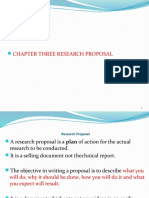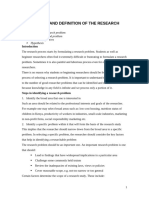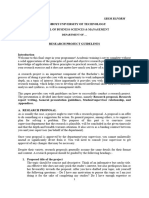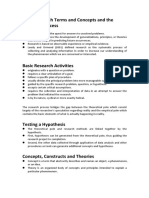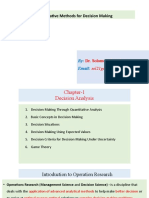Chapter 1
Uploaded by
Rei ReiChapter 1
Uploaded by
Rei ReiCHAPTER 1
I. Introduction of the Study
This presents the background of the study, introduction of the topic and an
overview of the whole paper. It also contains preliminary data about the topic
that the reader will most likely read. This ends with research questions, aims and
objectives.
A good introduction will:
1. Help the reader understand the topic’s background.
2. Explain why the research is worth reading.
3. Offer a guide for navigating the rest of the piece.
4. Pique the reader’s interest.
Content of a Good Introduction
1. Overview – Begin with a general overview of the research topic and then
narrowly address the paper’s specific subject.
2. Background of the Study- Review other conclusions on your topic from both
old and modern research.
3. Rationale- Explain why the topic needs to be addressed. If applicable,
connect it to current issues.
4. A thesis statement - Your main introduction should end with a thesis
statement. This statement summarizes the ideas that will run through your
entire research article. It should be straightforward and clear.
5. Outline - Introductions often conclude with an outline. Your layout should
quickly review what you intend to cover in the following sections. Think of it as
a roadmap, guiding your reader to the end of your paper.
Tips in Writing the Introduction
1. Write your introduction last. An introduction summarizes all of the things
you’ve learned from your research. While it can feel good to get your
preface done quickly, you should write the rest of your paper first. Then, you’ll
find it easy to create a clear overview.
2. Include a strong quotation or story upfront. You want your paper to be full of
substance. But that doesn’t mean it should feel boring or flat. Add a relevant
quotation or surprising anecdote to the beginning of your introduction. This
technique will pique the interest of your reader and leave them wanting
more.
3. Be concise. Research papers cover complex topics. To help your readers, try
to write as clearly as possible. Use concise sentences.
II. Statement of the Problem
This addresses an existing gap in knowledge in your field and leads to further
investigations by you and other researchers.
A statement of the problem should :
a. Specify and describe the problem.
b. Explain consequences of not solving the problem.
Once a research problem has been established, several questions can be
written down. These questions should specify exactly what needs to be
determined to address the problem.
These questions should also be specific enough that they can be answered
using appropriate available research methods - or methods that could be made
available to the research group (e.g. by buying or borrowing equipment).
These questions should require complex in-depth investigation, analysis,
and argument. They should not be simple enough that they can be answered
easily with well-established facts or yes/no answers.
All research questions should be focused, specific, appropriately complex,
and relevant to the overall aims of the project.
III. Theoretical/Conceptual Framework
What is a conceptual framework?
This is the researcher’s understanding/ hypothesis/exploration of either an
existing framework/model or how existing concepts come together to inform
a particular problem. It also shows the reader how different elements come
together to facilitate research and a clear understanding of results.
This can either be in graphic or narrative form – but should always be
explained and cited.
How to Make a Conceptual Framework
1. Start by identifying the key concepts used by other studies, then figure out
what needs to be done.
2. Pull out variables, concepts, theories and existing frameworks explained in
the RRL.
3. If you’re building a framework, start thinking about how some of those
variables, concepts, theories, and facets of existing frameworks come
together to shape your problem. The problem could be a situational
condition that requires a scholar-practitioner approach, the result of a
practical need, or an opportunity to further an application study, project,
or research. Remember, if the answer to your specific problem exists, you
don’t need to conduct the study.
4. Create a graphic representation of your framework (this part is optional,
but often helps readers understand the flow of your research)
Example of Frameworks:
IV. Scope and Delimitation
The scope of a study describes how deeply the research area will be
investigated in the work and establishes the limitations that the investigation
will operate.
Effective ways to start writing your scope:
This study aims to…
This study is to focus on…
This study covers the…
Delimitations are the parameters set by the researcher to determine what
to include and what to leave out of the research study. This includes sample
size, the environment or setting, population characteristics, etc.
Effective ways to start writing your study delimitations:
This study does not cover…
This study is limited to…
The following has been excluded from this study…
V. Significance of the Study
This explains why your research is important and why it should be conducted.
Possible reasons why a research is important:
The results of the study could lead to a better understanding of the
topic.
The findings of the research could have positive implications for
policy or practice.
Research could contribute to the body of knowledge in the field.
It justifies your research by demonstrating how it will contribute to
our understanding of the topic.
It helps to convince reviewers and funding organizations that your
research is worth supporting.
VI. Operational Definition of Terms
This is a detailed explanation of the technical terms and measurements used
during data collection. This ensures that the data is consistent when
interpreted by people of differing views.
You might also like
- 2-INQUIRIES-INVESTIGATION-AND-IMMERSION-MODULE-2No ratings yet2-INQUIRIES-INVESTIGATION-AND-IMMERSION-MODULE-239 pages
- Unit 3 Process in Research Proposal DevelopmentNo ratings yetUnit 3 Process in Research Proposal Development33 pages
- InquiresG12 q1 Mod2 Brainstorming-Your-Research v30% (2)InquiresG12 q1 Mod2 Brainstorming-Your-Research v329 pages
- How-To-Write-Chapter 1 of A Research-Paper - Independent-Study 1No ratings yetHow-To-Write-Chapter 1 of A Research-Paper - Independent-Study 129 pages
- Proposal and writing of a Research ReportNo ratings yetProposal and writing of a Research Report6 pages
- Writing A Research Report: Various FieldsNo ratings yetWriting A Research Report: Various Fields7 pages
- Chapter 2 Research Proposal and Its ComponentNo ratings yetChapter 2 Research Proposal and Its Component29 pages
- LAS III 12 MELC 2 Week 2-For-DistributionNo ratings yetLAS III 12 MELC 2 Week 2-For-Distribution10 pages
- Chapter 2: Identifying The Inquiry and Stating The ProblemNo ratings yetChapter 2: Identifying The Inquiry and Stating The Problem4 pages
- Identifying The Inquiry and Stating The ProblemNo ratings yetIdentifying The Inquiry and Stating The Problem4 pages
- Chapter 4 Research Proposal, Research Report Writing and Referencing (1)No ratings yetChapter 4 Research Proposal, Research Report Writing and Referencing (1)9 pages
- English 4 Lesson 2 Parts of A Research PaperNo ratings yetEnglish 4 Lesson 2 Parts of A Research Paper10 pages
- Drawing Conclusions From Research FindingsNo ratings yetDrawing Conclusions From Research Findings16 pages
- Developing and Organizing Your Research PaperNo ratings yetDeveloping and Organizing Your Research Paper46 pages
- How To Write Chapter 1 of Thesis Introduction100% (3)How To Write Chapter 1 of Thesis Introduction7 pages
- THE PROBLEM AND A REVIEW OF RELATED LITERATURE AND STUDIES AND ITRODUCTION - DISCUSSIONNo ratings yetTHE PROBLEM AND A REVIEW OF RELATED LITERATURE AND STUDIES AND ITRODUCTION - DISCUSSION5 pages
- Department of Education: Republic of The PhilippinesNo ratings yetDepartment of Education: Republic of The Philippines20 pages
- Department of Education: Republic of The PhilippinesNo ratings yetDepartment of Education: Republic of The Philippines20 pages
- How to Write a Dissertation: An Instructional Manual for Dissertation Writers.From EverandHow to Write a Dissertation: An Instructional Manual for Dissertation Writers.No ratings yet
- Mastering Business Research: A Practical Guide to Scholars and PractitionersFrom EverandMastering Business Research: A Practical Guide to Scholars and PractitionersNo ratings yet
- GIS Professionals Training Info 20191006 v2 UpdatedNo ratings yetGIS Professionals Training Info 20191006 v2 Updated4 pages
- III - Topic 1 Brainstorming For Research TopicsNo ratings yetIII - Topic 1 Brainstorming For Research Topics19 pages
- Download Full Strange Cases The Medical Case History and the British Novel Literary Criticism and Cultural Theory 1st Edition Jason Tougaw PDF All Chapters100% (8)Download Full Strange Cases The Medical Case History and the British Novel Literary Criticism and Cultural Theory 1st Edition Jason Tougaw PDF All Chapters82 pages
- Addressing The Future: Curriculum InnovationsNo ratings yetAddressing The Future: Curriculum Innovations90 pages
- W12 Extra Credit Quiz MATH 108X Reflection Math For The Real World PDFNo ratings yetW12 Extra Credit Quiz MATH 108X Reflection Math For The Real World PDF3 pages
- Differentiate Between Theoretical and Empirical Literature Review100% (1)Differentiate Between Theoretical and Empirical Literature Review8 pages
- Implicit Measures of Attitudes (Bernd Wittenbrink, Norbert Schwarz (Eds.) ) (Z-Library)No ratings yetImplicit Measures of Attitudes (Bernd Wittenbrink, Norbert Schwarz (Eds.) ) (Z-Library)306 pages
- Class VII English Honeycomb (Prose) Chapter 1. Three QuestionsNo ratings yetClass VII English Honeycomb (Prose) Chapter 1. Three Questions36 pages
- Bestmytest Toefl Reading Practice Test PDFNo ratings yetBestmytest Toefl Reading Practice Test PDF15 pages
- Galen. de Diebus Decretoriis, From Greek Into Arabic. Hunayn Ibn Ishaq (Glen Cooper)No ratings yetGalen. de Diebus Decretoriis, From Greek Into Arabic. Hunayn Ibn Ishaq (Glen Cooper)60 pages
- 2.1ATOMIC STRUCTURE - STUDENT - ppt16 - 17 PDF0% (1)2.1ATOMIC STRUCTURE - STUDENT - ppt16 - 17 PDF67 pages
- Sample Letter of Recommendation in Education - 20% (1)Sample Letter of Recommendation in Education - 25 pages
- Kamba-Comparative Law - Theoratical Framework100% (1)Kamba-Comparative Law - Theoratical Framework36 pages
- S3 Yearly Examination Syllabus 2010-2011No ratings yetS3 Yearly Examination Syllabus 2010-20114 pages
- Ninoy Aquino Elementary School Compound Maya-Maya St. Longos, Malabon City B. Rivera ST., Tinajeros, Malabon CityNo ratings yetNinoy Aquino Elementary School Compound Maya-Maya St. Longos, Malabon City B. Rivera ST., Tinajeros, Malabon City6 pages
- Individual Assignment of Basic StatisticsNo ratings yetIndividual Assignment of Basic Statistics9 pages
- Organizational Climate and Culture Schneider100% (1)Organizational Climate and Culture Schneider15 pages
- InquiresG12 q1 Mod2 Brainstorming-Your-Research v3InquiresG12 q1 Mod2 Brainstorming-Your-Research v3
- How-To-Write-Chapter 1 of A Research-Paper - Independent-Study 1How-To-Write-Chapter 1 of A Research-Paper - Independent-Study 1
- Chapter 2: Identifying The Inquiry and Stating The ProblemChapter 2: Identifying The Inquiry and Stating The Problem
- Chapter 4 Research Proposal, Research Report Writing and Referencing (1)Chapter 4 Research Proposal, Research Report Writing and Referencing (1)
- THE PROBLEM AND A REVIEW OF RELATED LITERATURE AND STUDIES AND ITRODUCTION - DISCUSSIONTHE PROBLEM AND A REVIEW OF RELATED LITERATURE AND STUDIES AND ITRODUCTION - DISCUSSION
- Department of Education: Republic of The PhilippinesDepartment of Education: Republic of The Philippines
- Department of Education: Republic of The PhilippinesDepartment of Education: Republic of The Philippines
- How to Write a Dissertation: An Instructional Manual for Dissertation Writers.From EverandHow to Write a Dissertation: An Instructional Manual for Dissertation Writers.
- Mastering Business Research: A Practical Guide to Scholars and PractitionersFrom EverandMastering Business Research: A Practical Guide to Scholars and Practitioners
- GIS Professionals Training Info 20191006 v2 UpdatedGIS Professionals Training Info 20191006 v2 Updated
- Download Full Strange Cases The Medical Case History and the British Novel Literary Criticism and Cultural Theory 1st Edition Jason Tougaw PDF All ChaptersDownload Full Strange Cases The Medical Case History and the British Novel Literary Criticism and Cultural Theory 1st Edition Jason Tougaw PDF All Chapters
- W12 Extra Credit Quiz MATH 108X Reflection Math For The Real World PDFW12 Extra Credit Quiz MATH 108X Reflection Math For The Real World PDF
- Differentiate Between Theoretical and Empirical Literature ReviewDifferentiate Between Theoretical and Empirical Literature Review
- Implicit Measures of Attitudes (Bernd Wittenbrink, Norbert Schwarz (Eds.) ) (Z-Library)Implicit Measures of Attitudes (Bernd Wittenbrink, Norbert Schwarz (Eds.) ) (Z-Library)
- Class VII English Honeycomb (Prose) Chapter 1. Three QuestionsClass VII English Honeycomb (Prose) Chapter 1. Three Questions
- Galen. de Diebus Decretoriis, From Greek Into Arabic. Hunayn Ibn Ishaq (Glen Cooper)Galen. de Diebus Decretoriis, From Greek Into Arabic. Hunayn Ibn Ishaq (Glen Cooper)
- Ninoy Aquino Elementary School Compound Maya-Maya St. Longos, Malabon City B. Rivera ST., Tinajeros, Malabon CityNinoy Aquino Elementary School Compound Maya-Maya St. Longos, Malabon City B. Rivera ST., Tinajeros, Malabon City




















